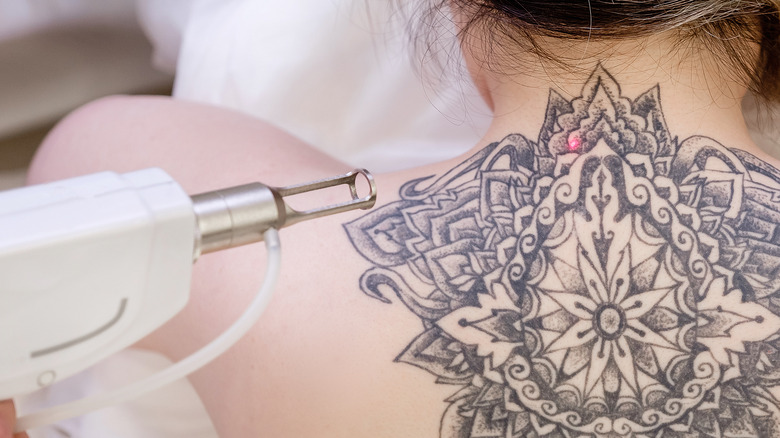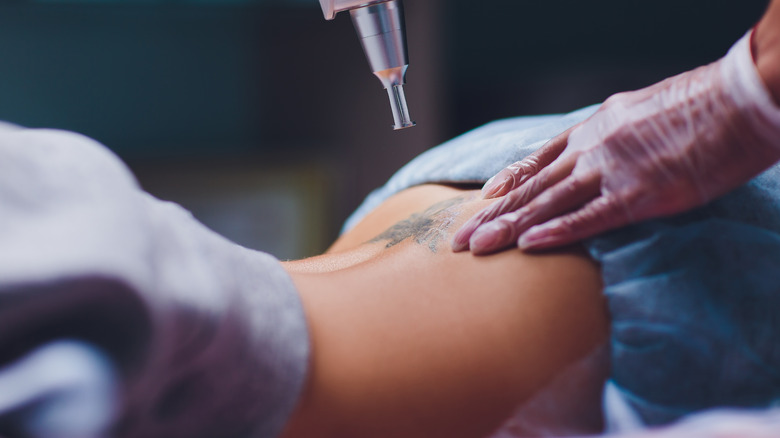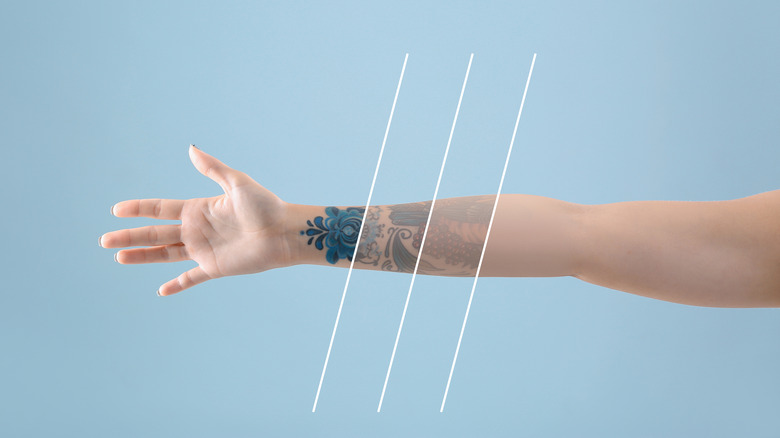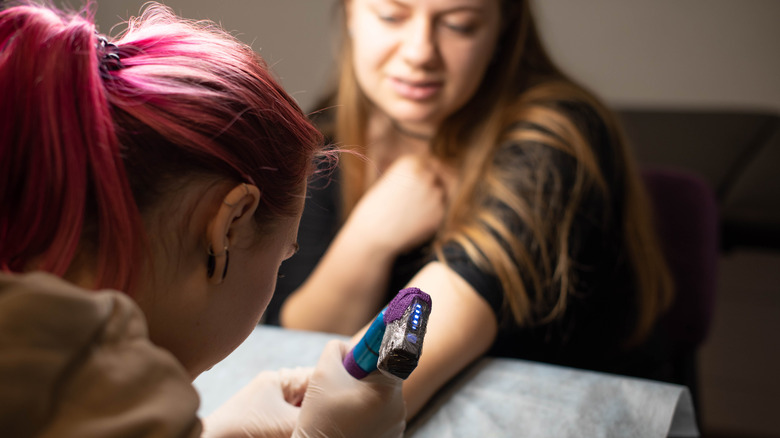The Science Behind Tattoo Removal
Unfortunately, not all tattoos age like fine wine. Maybe your first stop when you turned 18 was the tattoo shop, where you got the grim reaper tattooed on your entire back. Or maybe you got matching tattoos with your best friend at the time, only to have a blowout fight a year later and never speak to them again. Actually, the most common reason people regret getting a tattoo is because their tattoos relate to past relationships and they don't want a constant reminder of their past love, according to How Stuff Works.
Tattoos are usually performed with a mechanical or hand poke needle. Tattoo artists pierce the skin, delivering permanent ink into the dermal layer of skin (via How Stuff Works). Tattoos have nearly always existed in some fashion; Winston Churchill's mother had a serpent tattooed around her wrist, per The Guardian. But in recent years, the tattoo industry has exploded — increasing by 10% every decade — with 29% of U.S. adults reporting they had at least one tattoo in a 2015 Harris Poll (posted at PR Newswire). Of course, with more tattoos come more tattoo regrets and, therefore, tattoo removals.
Which tattoos can be removed?
According to How Stuff Works, complete tattoo removal is impossible. That's partially because it is hard for dermatologic surgeons to predict how much of a tattoo they will be able to remove because the removal process is impacted by many factors, including the size of the tattoo, where it is on the body, and how well the tattoo was applied. However, the science of tattoo removal has been improving in recent years.
Per How Stuff Works, it's typically easier to remove tattoos done by more skilled artists because all ink will be injected in the same level of the skin, as opposed to less experienced artists who may not have as steady a hand. Black ink is also typically easier to remove than colored ink, according to The Science Explorer. Generally tattoo pigments are listed as "color additives" by the U.S. Food and Drug Administration, without further designation. However, there are some 100 tattoo inks on the market today being used. That means it can be difficult for doctors to match which removal technique is best for the procedure without knowing which type of ink was used by the artist (via How Stuff Works).
How were tattoos removed in the past?
Tattoos used to be removed through a few different ways that were often painful and left scars on the skin. One technique called dermabrasion sounds just as abrasive as it is. Tattoo removers would sand down the skin to remove the layers until they had reached the ink (per How Stuff Works). Another technique, sometimes paired with dermabrasion, was called cryosurgery. It involves freezing the skin beforehand, according to How Stuff Works.
The third manner, called excision, was used by dermatologic surgeons to remove tattoos with a scalpel. After scooping out the tattoo from the skin, the surgeons would stitch up the skin in its place or pull skin from other parts of the body to cover up the wound in a skin graft (via How Stuff Works). Luckily, the use of Light Amplification by the Stimulated Emission of Radiation, or lasers, were developed in the 1960s and became a popular replacement for some of the more painful tattoo removal techniques (per How Stuff Works).
How do the lasers work?
Different lasers, which deliver bursts of high energy to the skin in pulses, are used for different types of colors in a process called Q-switching. Essentially, the laser's energy is absorbed by the tattoo's ink, causing it to break apart into particles that the body can then dispel using its immune system (via How Stuff Works). This process, called photothermolysis, is also used for hair removal, according to The Science Explorer.
Each type of laser is specifically attracted to a certain color, which can be made from heavy metals like lead, copper, and manganese. These metals give them their permanence and make them hard to remove. The lasers can pass through the other layers of the skin with no effects (via The Science Explorer). The "Q-switched Nd: YAG" is the newest development in this method and is used most effectively with red, blue, and black inks.
Does it hurt?
Some people compare the process of tattoo removal to getting the tattoo itself. The laser's pulses can feel like "hot specks of bacon grease on your skin or being snapped by a thin rubber band," according to How Stuff Works. Most removals also take anywhere between five to 10 treatments, at least a few weeks apart (per New Look Laser College). That's because not all of the ink under the skin will be broken apart with a single treatment. And if an artist applied the ink to multiple layers of the skin, the lasers will only target the layer of skin closest to the surface in the first go-round, making multiple sessions typically necessary.
Sometimes light bleeding can occur, as when you get a tattoo, and the skin might be red or hyper-pigmented where the lasers struck it (via How Stuff Works). The skin might also scab, but any redness, soreness, or scabbing should gradually fade. Overall, it might be a good idea to take an over-the-counter pain reliever before going in to get your tattoo removed, but you will likely discuss this with your doctor if you're interested in removing some ink. According to How Stuff Works, there is a 5% chance of permanent scarring associated with the procedure.
How much does it cost?
Although your original investment in a tattoo could have put you out hundreds or even thousands of dollars, laser removal tends to be even more expensive. According to Glamour, each visit (and there will be many) can cost hundreds of dollars. In an analysis by The American Society for Aesthetic Plastic Surgery, each session costs on average $463. On top of that, you'll probably also need to buy some products for aftercare, like bandages, moisturizer, and even different shirts that don't irritate the skin during the healing process (via Glamour).
Because of the costs involved, laser tattoo removal might not be accessible to everyone. Another option if you have an ugly dragon or an ex-lover tattooed on your body that you want to get rid of is to get a cover up tattoo. These days, some tattoo artists specialize in cover-up tattoos, artfully transforming the tattoo you don't want anymore into something you're comfortable with.





